 |
 |
News |
|
 |
| |
|
|
| Several RC magazines around the world have asked us to write a monthly column. With the kind permission we will re-publish the column at our web site too so all of the XRAY fans can read the latest news and behind the scenes information. Enjoy. |
|
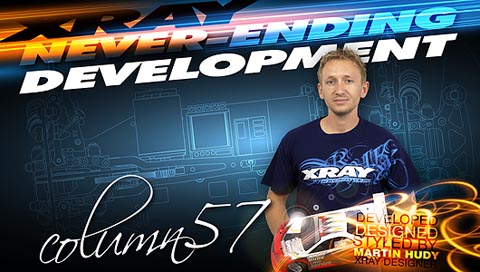
(click to enlarge) |
|
|
|
The electric touring car category was the first category we entered the market back in 1999 and since Day 1 we have had ongoing development. During the last 12 years we introduced new versions of the electric touring car: T1 ⓠT2 ⓠT3, always pushing the limits. It is a certainty that the ongoing development and our maximum attention to the smallest details combined with our very professional approach to everything we made XRAY touring cars some of the most successful in the world. Every year when we finish all the details for the new car I say to myself that once again we have outdone ourselves, while in the back of our minds we realize we are making it even MORE difficult to come up with something new or better the next time around. But as the year progresses we always face new challenges and new situations, and come up with new ideas which come from our own experiences or (in many cases) come from the team drivers⦠and in MANY cases the ideas come from our end customers too. As such, every year we find ourselves in the position that the list of ideas gets so large that sometimes we have to reprioritize and postpone some of the ideas or new improvements until the following year due to time constraints and deadlines.
The electric touring car category has been the category which has faced so many big changes both in rules and especially in development. Not only tires and bodies but especially the electronics â“ batteries and motors â“ were changing and improving almost every week or month, and we have seen big changes in car development as well. Of course every manufacturer wanted to capitalize on the potential which new developments brought, so we all had to react quickly and decisively. Sometimes it was not a new technological development which pushed the car development but rather it was new rules such as a lowered weight limit of 1350g. Another time it was a change in preferences of customers, such as changing from foam tires to rubber tires. All of these changes over the last 12 years came very fast, were very challenging, and they sure kept us busy! It is now the end of the 2011 summer season and now the winter season starts⦠so it is time for the new version of XRAYâ™s electric touring car: the 2012 version of the T3. |
|
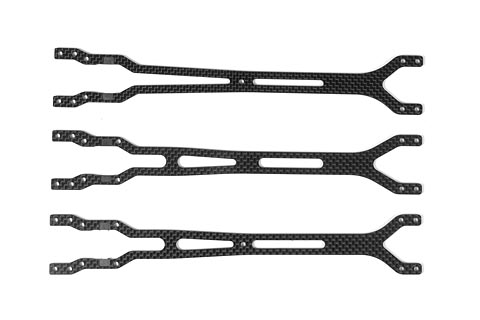
selection from all the different prototypes made
(click to enlarge) |
|
|
|
The T3â™12 was in some ways a very different project for me personally. After foam tire racing died out completely, we have focused primarily on rubber-tire car development. Since racing on carpet and asphalt are very specific and different, we wanted to push the development of the T3 to make it work perfectly in both conditions. So this time things were a little different but let there be no doubt: it was an extremely difficult challenge. The other part which made things very different and new was that this time I was not the main designer of this car anymore. For the past several years the electric touring car development was by and large the responsibility of Martin Hudy, but this year was the first time he took over the entire project and handled all aspects of it. Despite our basing the car around the current T3 platform, with this project we had another extremely difficult challenge â“ we had just implemented an all-new CAD/CAM database management software. The new database CAD software required that we had to redraw every single drawing and part we ever did to get it into the database. As such, Martin had to start from the proverbial âśSquare Oneâť and take all the âśoldâť parts (which were supposed to be used for the new car) and re-draw them to get them into the new database system. In some ways I am very happy that it was not ME that had to do that.
Usually when a new version of the car is being finished and gets into the market, we have already started to work on the next version of the car. Over the year we test plenty of different new parts and whenever anyone asked me âśwhat is thisâť or âśthatâ™s different on my carâť I just have to say that it is just some new parts we are testing but nobody knows what will make it into the final kit, neither I. At the end, the majority of the parts we test during the year never get into mass production or into the next version of the car simply because they do not bring major improvements in performance, handling or reliability or we donâ™t get completely positive feedback from all team drivers which is one of our main criteria to approve any prototype. On the other hand there are some parts which make such big improvements that we cannot wait until the next version of the car and so we make those parts available almost immediately. |
|
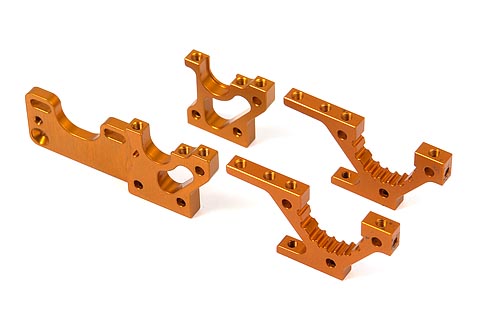
some different flex mounting positions were tested as well
(click to enlarge) |
|
|
|
This was the case with the gear differential which we developed and produced prototypes for during the 2011 season, and feedback has been really very positive. The design focused on making the diff leak free, to be compatible with 52mm drive shafts, and to make it not only super-reliable but especially ultra light as drivetrain mass has a huge impact on performance. I am very satisfied with the gear differential, and it is at the moment the lightest differential in the market and the internal gears are even compatible with the NT1 differential! It was difficult decision either to wait and put the diff into the next version of the car, or to make it available immediately. In the end, the overwhelmingly positive feedback from everyone convinced us not to wait.
Already during 2011 we successfully tested the newly-designed roll center holders which allow faster and easier roll center adjustment as well as making linkage length easier to adjust in both front and rear. With positive feedback from the entire team it was another part which was approved for the 2012 specs. |
|
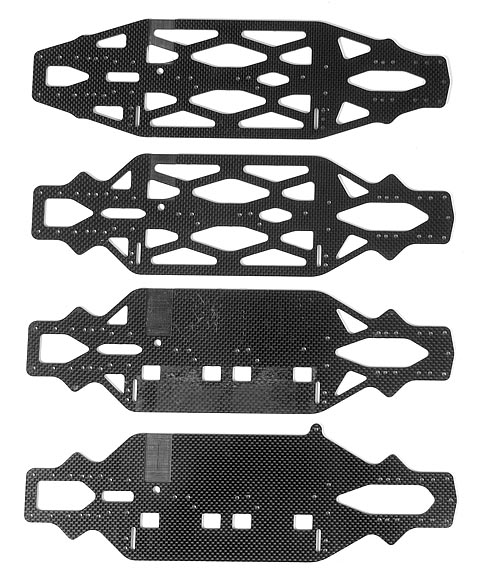
selection from all the different prototypes made
(click to enlarge) |
|
|
|
One of the most frequently repeated comments on the 2011 specs from customers was the lack of available space for comfortable electronics placement and I had to agree with those comments. As such, very early in 2011 we were already testing new chassis layouts with servo positioned horizontally to get more space on the chassis for electronics. This new chassis layout allowed a redesign of the top deck, similar to the earlier T3 version with the single central servo saver. Ah, the servo saver⦠this is another part which we improved after feedback from customers who wanted to get more precise high-speed steering and as such we changed to a 4-spring servo saver which is certainly an improvement, another part made based on the requests from customers.
All of these parts were a logical result of new experiences, collected feedback, and the requirements of end customers. Our main focus and the most difficult area were to find the optimum flex of the car which is one of the most important handling characteristics which influences performance. In short, the goal was to design a chassis and top deck from a material which would provide sufficient traction on both carpet and asphalt tracks. |
|
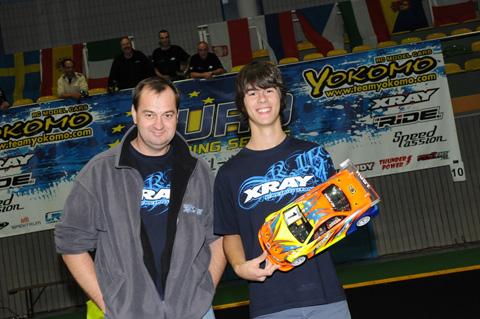
(click to enlarge) |
|
|
|
At the EC warm-up race I started with a standard chassis and compared it with a specially-lightened chassis with cut-outs on the sides. Later on I used a chassis with large openings below the front suspension and another one with large opening below the rear suspension. All these changes increased traction but I still felt we could do and gain more. After the EC warm-up we went back to computer and increased both front and rear openings on the chassis, produced some prototypes and by the end of the week we were back on the EC track for private testing.
From the early beginning the new changes to the chassis have been very positive and gave us more traction, but as soon as the trackâ™s grip started to increase the car got more twitchy and more difficult to drive. So in the end I had to return to the previous version with less cut-outs. The handling returned back to where I liked it but still I needed more steering so I tested the very first T3â™s single aluminum holders which are used in the front of the rear suspension. This change immediately generated more steering but also overall traction. For the rest of the outdoor season on asphalt I have used this combination which worked very well for me.
As soon we returned to indoors, all the positive feelings I had were gone. The front of the car was diving too much into the corners so I had to change back to the regular 1-piece suspension holders at the rear of the front suspension. The new chassis was very good on carpet tracks when grip was low or medium, but as soon the grip of the carpet started to build the car became more difficult to drive. As such, all of the positive feelings we had from the outdoor results were gone and we had to go back to change the design of the chassis again. Back & forth development and testing. |
|
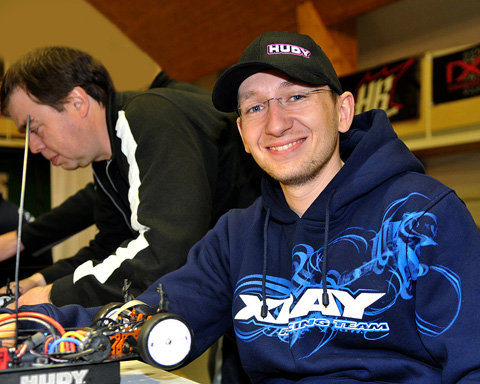
(click to enlarge) |
|
|
|
Martin spent several weeks designing and testing the different chassis designs. Thanks to the all in-house manufacturing technologies which allowed changing our new ideas and experiences into new pieces in only a few minutes, we were caught in never-ending loop. At the end I believe we made maybe 15-20 different chassis designs. Of course the performance of the chassis design goes hand in hand with the top deck design so any time any changes were made to the chassis we had to adjust the top deck as well. All of this to find the optimum balance of maximum traction and steering, while maintaining the overall balance of the car.
At the end we selected a few favorites which worked well on the carpet track but we needed to double-check them on the asphalt track. At the end of September at our factory outdoor track, we had an XRAY Challenge final with around 100 drivers. The perfect conditions to test in! The track was cold in the morning, during the day it was hot, and in the evening it got cold again, so we had perfect different conditions to test under. At the same time we were testing the final versions of the chassis and top deck. These were tested by our team drivers to get confirmation from everyone else that the final designs were the best choices we could make. The results of our own testing were positive and to get definitive confirmation I waited for several reports from team drivers. Since it was already the end of September and we needed to deliver the new cars in mid-October, there was not much time left.
I actually got a bit nervous because if we got some negative feedback it could delay the project and in that case it was possible that we could miss our deadline. Of course, all parts such as drivetrain parts, shock parts, suspension parts, all of which were already confirmed were running in production and we were just waiting for the final approval of the chassis, top deck and some few other parts. Finally the first reports from team drivers started to arrive and once most of the feedback was already in my hand and all of them had positive results, we started production of all the graphite parts and finished the kits. While it takes to other companies months to arrange production, we accomplished the same within a few short weeks and I was very happy and satisfied when we stared to export the first kits on time. Of course we could not possibly achieve such record short times if we did not have the entire production in-house, and that would have meant plenty of disappointed customers who would not get their new T3 on time. |
|
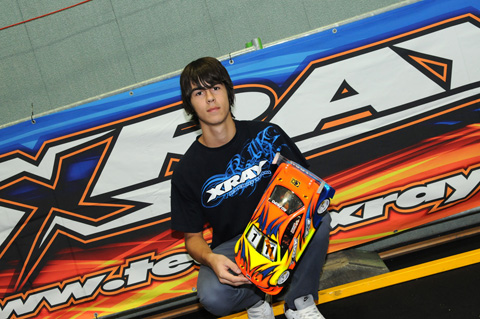
(click to enlarge) |
|
|
|
For several years the first round of the ETS marks the opening race of the indoor season, and I was very happy that this year we did it again. We managed to put all the drawings into the new database system to make the car on time. We managed to do the most difficult on time â“ testing dozens of different parts and make time-critical decisions as to which one would make it into final production. And we were able to produce all parts on time for the first race of ETS.
After the last minute production stress I finally calmed down a bit, only to get re-stressed going to the ETS race to debut the car a few days later. The debut race is extremely important for any company, and at such races I feel always very nervous. Luckily my nerves went away after the first practice rounds as the T3â™12 was in the hands of team drivers but also regular customers were performing to everyoneâ™s satisfaction. In Modified category, Zdenko Kunak and Alex Hagberg qualified into the main final in the very competitive field of 110 drivers. Alex missed the final podium by only a fraction, having same points but finishing 4th. Both Alex and Zdenko had very competitive performances, setting lap times as fast as the best drivers at the event. Everyone was very happy with the performance. |
|
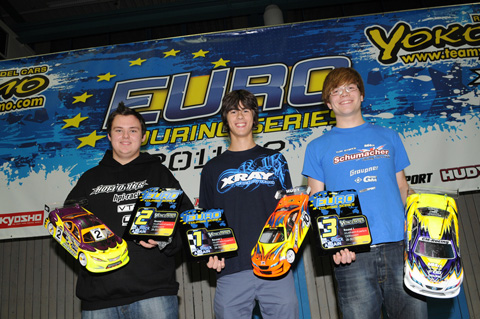
(click to enlarge) |
|
|
|
It was very satisfying to receive appreciation and comments from the team drivers but especially from regular customers that the T3â™12 was their best-performing car ever. And this was also proven again in the Stock category with very high and tight competition among 166 drivers. Zdenko Kunak set the TQ pace, and two other XRAY drivers made it into the main final.
Zdenko continued his performance on Sunday when he won the main finals to put the crowning touch on the debut of T3â™12. What a perfect debut for the very hard and dedicated work of the entire XRAY team. I was also very happy for Zdenko as this was his first major win, so I was pleased it was at this race and with the new car.
Another year has passed and another project was finished, and the very hard work of the entire XRAY team has paid off. I am very proud of the work of everyone on the team, and I am very proud that Martin has successful managed such complex, demanding, and very challenging project. There are very few true RC car designers in the world, and I am very happy and proud that I have my protégé coming up and we can expect more great stuff coming. Good job everyone, good job Martin. |
|

|
See you around the tracks!
Enjoy the ride and â�til next time,
Dipl. Eng. Juraj Hudy
XRAY Chief Designer
|
| Archive: |
|
Column #1 - Behind the Scene Stories
Column #2 - Worlds Flashback
Column #3 - T2'007 Debut
Column #4 - Designing the T2'007
Column #5 - Worldcup Review and NT1 Testing
Column #6 - Developing and Designing the NT1
Column #7 - Developing and Designing the NT1 - Part 2
Column #8 - Back to the Races
Column #9 - XT8 Truggy Development
Column #10 - Touring Car Development
Column #11 - Bling-bling Mentality
Column #12 - Hot Summer Washout
Column #13 - New Electric Touring Car
Column #14 - Off-road Development
Column #15 - My micro love
Column #16 - Back in the Dirt
Column #17 - Worlds Preparations
Column #18 - 808 Tests & Stress
Column #19 - Excited for the Worlds?
Column #20 - Statistics, Expenses Sheets, Production Analysis, Calculationsâ¦
Column #21 + Column #22 - Euros + Euros + Worlds
Column #23 - The Busiest Season Ever
Column #24 - In Between the Worlds
Column #25 + Column #26 - Well Developed or Overdeveloped?
Column #27 - Back to The Future
Column #28 - 2009 Kick-off
Column #29 - Crazy what?
Column #30 - Last indoor race of the season
Column #31 - Getting into summer season
Column #32 - Heading for the Euros
Column #33 - Testing - Always last minute, always new ideas
Column #34 - European Champion - title celebration
Column #35 - Time to move on
Column #36 - National Heroes
Column #37 - 2010 ready
Column #38 - Decade of Triumph
Column #39 - 2010 Racing Calendar
Column #40 - DHI, ETS & NĂĽrnberg Show
Column #41 - World Championship Practice
Column #42 - EC indoor, EC 1/12, Silverstate, LRP Masters, Neo
Column #43 - Nationals All Around
Column #44 - Warm Warm-ups, Challenging Challenges
Column #45 - Electric Touring Worlds 2010
Column #46 - Team XRAY - World Champion!!!
Column #47 - Summer Vacation, 30x USA Champion Title
Column #48 - T3 Saga Continues
Column #49 - RX8 â“ What? How? When?
Column #50 - The Making of the RX8 â“ Part II
Column #51 - Shake It, Baby, Shake It...
Column #52 - Racing Season â�11 Full Running
Column #53 - From On-road to Off-road
Column #54 - Testing and Once Again⦠Testing
Column #55 - Half of the EC Championships â“ Done!
Column #56 - Summer is Goneâ¦Euros are Done |
|
|
|
|























